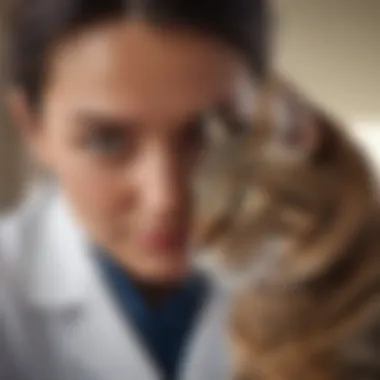Recognizing UTI Symptoms in Cats: A Complete Guide


Intro
Utinary tract infections, known commonly as UTIs, are a significant health concern for cats. Understanding the symptoms can lead to timely intervention and better outcomes for our feline friends. This section will set the stage for exploring the unique aspects of cat health related to UTIs.
Understanding Your Pet
Breed Traits
Certain breeds may be more predisposed to urinary issues. For instance, Persian and Maine Coon cats are noted for their susceptibility. Recognizing these traits can help in being vigilant about symptoms that indicate a UTI.
Common Temperaments
Cats have varying temperaments which affect how they exhibit discomfort. Some may hide their pain or behave unusually. Watch for signs like decreased playfulness or hiding more than usual. Owners should be aware of their pet's normal behavior to catch discrepancies early.
Special Needs
Some cats require more attention, especially if they have a history of urinary tract issues. Be proactive about regular vet visits to monitor their health. Tailored care ensures they remain healthy and comfortable.
Pet Care Essentials
Nutrition and Feeding Guidelines
A balanced diet plays a crucial role in preventing UTIs. Cats benefit from wet food, which helps keep them hydrated. Providing fresh water always is essential. Certain ingredients, like cranberry extract, may also support urinary health.
Grooming Tips and Techniques
Regular grooming helps maintain your cat's overall health. While not a direct factor in UTI prevention, reducing stress and promoting hygiene is crucial. Pay attention to the litter box habits; changes can signal a problem.
Health and Wellness
Regular wellness checks are vital. Vaccinations and routine blood work help detect problems early. Discuss any changes in your cat's drinking or urination patterns during vet visits.
Training and Behavior
Basic Training Techniques
Teaching a cat basic commands improves the human-animal bond, making it easier to monitor their behavior. Positive reinforcement techniques can help in shaping behaviors that facilitate health monitoring.
Behavioral Problems and Solutions
Unusual behaviors, such as excessive licking or frequent trips to the litter box, can indicate distress. Identifying the root cause is essential for effective treatment. Consulting with a vet or a behaviorist may be prudent.
Mental Stimulation Activities
Mental exercises such as puzzle toys can distract from discomfort and provide enrichment. Mice and feather teasers can keep a cat active, which helps in overall wellness.
Engaging with Your Pet
Interactive Games and Toys
Engaging your cat in play can divert their attention from potential health issues. Toys that mimic prey behavior boost their hunting instincts and provide necessary exercise.
Safe Outdoor Activities
Supervised outdoor time can improve your cat's mood. Offer a safe space for exploration while ensuring they do not come into contact with environmental hazards that may affect their health.
Family-Friendly Pet Interactions
Cats are social creatures. Teaching family members, especially children, how to properly interact with a cat can boost their confidence and reduce stress for both parties, leading to better overall health.
Pet Adoption and Integration
Choosing the Right Pet for Your Lifestyle
Consider your lifestyle when adopting. Research breeds that are less prone to health issues, including UTIs. A well-suited pet enhances harmony in the household.
Preparing Your Home for a New Pet


Set up a comfortable space for your new cat. Have essential supplies ready, including a litter box, food, and water dishes, which will help the cat adjust more easily to their new environment.
Tips for Smooth Foreword
If you have other pets, introduce them slowly. Monitor their interactions to ensure a peaceful coexistence. Proper introductions can prevent stress-related issues down the line.
Understanding UTI symptoms and their management can significantly improve your feline's well-being. Being observant and proactive lays the foundation for a healthy pet.
By focusing on these aspects, cat owners can create an environment that supports the health and well-being of their pets, while also being prepared to address potential urinary tract infections effectively.
Foreword to UTI in Cats
Definition and Importance
A urinary tract infection (UTI) in cats is a common health issue that can lead to various serious complications if left untreated. UTIs occur when harmful bacteria invade the urinary system, affecting the bladder, urethra, and even the kidneys. The importance of understanding UTIs in feline companions cannot be overstated, as these infections can significantly compromise their health and overall quality of life. Early recognition of symptoms and effective management can prevent potential health hazards. Moreover, addressing UTIs promptly aids in promoting the longevity of a cat's life and ensures that they remain comfortable and healthy.
It's essential for cat owners to recognize that UTIs can mimic other illnesses. This similarity can complicate diagnostics if one isn't attentive to specific signs. Therefore, an informed approach to feline urinary health is critical. By understanding UTIs, pet owners can take proactive measures to maintain their feline friends' well-being.
Prevalence of UTIs in Felines
Urinary tract infections are relatively common in cats, affecting a diverse range of felines regardless of their age, breed, or sex. Recent studies indicate that up to 3% of cats may experience a UTI at some point in their lives. Factors such as age, lifestyle, diet, and existing health conditions play significant roles in the prevalence of UTIs.
Younger cats tend to be more susceptible due to their developing immune systems. Conversely, older cats, particularly those with chronic health issues, also exhibit higher rates of infection. Certain breeds, such as the Persian and Siamese cats, have been noted to show increased susceptibility.
Additionally, environmental factors like poor hygiene in the litter box or water supply can contribute to the risk of UTIs. Awareness of these factors, alongside understanding the symptoms, will empower pet owners to provide care that significantly reduces the likelihood of urinary tract infections. Ultimately, early detection and treatment are crucial in preserving a cat's health.
Recognizing UTI Symptoms in Cats
Recognizing UTI symptoms in cats is crucial for pet owners. Urinary tract infections can lead to significant distress and health issues if not treated timely. By understanding how to identify these symptoms, owners can act quickly and improve their cat's overall well-being. Awareness can lead to better quality of life for affected cats and may prevent serious complications.
Common Symptoms to Observe
Cats suffering from UTIs typically show a range of symptoms. Common signs to watch for include:
- Frequent urination or straining to urinate.
- Blood in urine, which can appear pink or reddish.
- Strong or foul-smelling urine.
- Licking of the genital area more than usual.
- Increased vocalization, especially during urination.
These symptoms can indicate that a cat is in discomfort. The presence of any of these symptoms warrants immediate veterinary consultation.
Behavioral Changes Indicative of UTI
Apart from physical symptoms, cats may alter their behavior when experiencing a UTI. Some possible behavioral changes include:
- Increased agitation or restlessness.
- Avoidance of usual litter box or urination spots.
- Hiding or retreating, which could signify pain.
- Changes in eating habits or reduced appetite.
Cats are skilled at hiding discomfort, so subtle changes can be significant. Observing these behavioral shifts can help owners realize when their cat might need medical attention.
Physical Signs of Urinary Issues
Physical signs often accompany the aforementioned symptoms. Owners should look for:
- Swollen abdomen, indicating discomfort.
- Weight loss due to changes in eating habits.
- Fur that may appear unkempt, presenting a lack of grooming.
These signs reflect the underlying health issues affecting the cat. Vigilance in monitoring these physical conditions is essential for early diagnosis, which can lead to more effective treatments.
Early identification of UTI symptoms can lead to better outcomes and minimize suffering for your cat.
In summary, recognizing UTI symptoms in cats involves a combination of observing common indicators, behavioral changes, and physical signs. Being proactive can ensure that your feline companion receives the appropriate care and remedy as soon as possible.
Potential Causes of UTIs in Cats
Understanding the potential causes of urinary tract infections (UTIs) in cats is vital for several reasons. First, identifying the underlying causes can help in tailoring effective treatment plans. Second, it aids pet owners in recognizing risk factors, allowing for proactive measures to be taken. Finally, a comprehensive grasp of these causes informs ongoing management strategies and helps prevent recurrences.
Bacterial Infections
Bacterial infections are one of the primary culprits behind UTIs in cats. In most cases, bacteria enter the urinary tract through the urethra. This can happen when there is a disruption in the natural barriers that typically fend off pathogens. Common bacteria responsible for UTIs include Escherichia coli, which is prevalent in the intestinal flora. Other species, such as Staphylococcus and Proteus, may also play a role.
The presence of bacteria in the urinary tract creates an inflammatory response. Cats may exhibit symptoms such as frequent urination and discomfort while urinating. This highlights the necessity of recognizing how bacterial infections can initiate a cycle that leads to further complications. It is crucial that pet owners seek veterinary care promptly should they suspect their cat might have a UTI. Early intervention can help minimize suffering and avoid potential kidney damage.
Anatomical Factors


Anatomical factors can also contribute to the likelihood of UTIs in cats. Cats, particularly females, have shorter urethras than males. This anatomical difference means that bacteria can ascend more easily to the bladder. Furthermore, certain breeds may be predisposed to structural changes that affect urinary tract function. For example, Persian cats often experience genetic variations that can result in urinary blockages.
In addition, issues such as bladder stones or urinary crystals can obstruct urine flow, creating an environment conducive to infection. Understanding these anatomical considerations allows pet owners to recognize when their cat might be at higher risk of developing a UTI. Proper monitoring and routine veterinary evaluations are essential in these cases to prevent complications.
Underlying Health Conditions
Underlying health conditions can significantly increase a cat's vulnerability to urinary tract infections. Conditions such as diabetes mellitus, hyperthyroidism, and chronic kidney disease disrupt normal bodily functions and alter urinary pH levels. These changes create an ideal environment for bacteria to thrive.
Moreover, cats with compromised immune systems are more susceptible to infections. If a pet owner observes signs such as frequent thirst or excessive urination, they should consider seeking veterinary advice. Diagnosing and managing these underlying conditions not only assists in treating UTIs but also improves the overall health of the cat.
Recognizing the causes of UTIs is essential for effective prevention and management. Pet owners who understand these factors can better safeguard their feline companions from this painful condition.
Diagnosing UTI in Cats
Identifying urinary tract infections in cats is a critical aspect of ensuring their well-being. Accurate diagnosis leads to timely treatment, which can prevent complications. Urinary issues can stem from various underlying causes, making it imperative for pet owners to actively recognize symptoms and seek veterinary assistance. This section will explore the essential procedures that veterinarians use to diagnose UTIs in cats, including examination techniques and laboratory tests.
Veterinary Examination Procedures
When a cat presents with potential UTI symptoms, the vet's first step is a thorough physical examination. This process includes assessing the cat’s overall health and condition. Vets often look for signs, such as discomfort when palpating the abdomen or observing the cat's reactions during the examination.
Key components of the examination may include:
- Assessment of Medical History: It's important to gather information on dietary habits, previous health issues, and any recent changes in behavior or appetite.
- Observation of Symptoms: Signs such as frequent urination, straining to urinate, or blood in the urine can indicate a UTI. Vets observe these symptoms closely.
- Palpation: The veterinarian may gently press on the cat's abdomen to check for pain or swelling in the bladder region, which could signal a urinary problem.
- Urinalysis: A vital step in diagnosing a UTI involves obtaining a urine sample. This can be done through free catch, catheterization, or cystocentesis.
Vet examinations provide valuable insights. An experienced veterinarian can often determine if further investigation is necessary based on physical findings and symptoms.
Laboratory Tests and Results Interpretation
Once a urine sample is obtained, laboratory tests provide substantial information to diagnose UTIs accurately. A urinalysis evaluates the physical and chemical properties of the urine, helping identify any abnormalities.
Important aspects of laboratory tests include:
- Chemical Analysis: This test assesses components like pH levels, specific gravity, and the presence of glucose or protein, all of which may indicate health issues.
- Microscopic Examination: This involves looking for cells, crystals, bacteria, and even yeast under a microscope. The presence of bacteria is significant for diagnosing a UTI.
- Culture Tests: A culture test helps identify the specific bacteria causing the infection. This step is crucial for determining the most effective antibiotic treatment.
Interpreting results requires expertise. For instance, normal pH levels can rule out certain conditions, while the presence of nitrates or leukocyte esterase may confirm infection. Understanding these findings aids in crafting an effective treatment plan tailored to the cat's specific situation.
Accurate diagnosis is the first step toward successful treatment. Early detection can make all the difference in your cat's recovery.
Treatment Options for Cats with UTI
The treatment of urinary tract infections in cats is a critical aspect discussed in this overview. Addressing UTIs promptly can prevent further complications and improve the quality of life for affected felines. Treatment may involve different strategies depending on the severity and root cause of the infection. Understanding these options helps pet owners navigate the course of action necessary to ensure their cats receive appropriate care. Effective treatment can facilitate quicker recoveries and mitigate the chances of recurrence.
Antibiotic Therapy
Antibiotic therapy forms the cornerstone for treating bacterial UTIs in cats. When a cat shows symptoms of a UTI, such as frequent urination or discomfort, a veterinarian typically conducts tests to identify the specific bacteria involved. Once diagnosed, the appropriate antibiotic is prescribed. Common antibiotics include amoxicillin, clavamox, or trimethoprim-sulfa, among others.
Antibiotics need to be administered as per the veterinary instructions. Completing the full course is vital, even if symptoms improve early in treatment.
Pet owners should monitor their cat during this phase for any side effects, such as gastrointestinal upset. Additionally, informing the vet about any current medications can help avoid adverse interactions. This therapy usually lasts from several days to weeks, depending on the infection's severity.
Dietary Management and Nutrition
Dietary management is an important adjunct to treating UTIs and can play a role in preventing future occurrences. A well-balanced diet geared towards urinary health can be beneficial. Specially formulated cat foods are available, aimed at promoting urinary tract health. These diets may help maintain optimal pH levels in urine, reducing the likelihood of bacterial growth.
Cats are naturally inclined to low moisture intake, contributing to concentrated urine. Encouraging increased water consumption can help dilute the urine, making it less hospitable for bacteria. Owners can achieve this by:
- Introducing wet food into their cat's diet.
- Using water fountains to attract cats to drink more.
- Adding water to dry food.
It's crucial to consult a veterinarian before making significant changes to a cat’s diet, especially if the cat has existing health issues.
Surgical Interventions (if necessary)
In some situations, surgical intervention may be necessary, especially if there are underlying anatomical abnormalities or obstructions. Conditions such as bladder stones or tumors may require surgical removal to resolve recurrent UTI issues. Surgical options however depend on the unique health profile of the cat and the specific diagnosis.
Should surgery be indicated, it is essential to discuss the risks and benefits with a veterinarian. Post-operative care will be vital to ensure proper recovery and to watch for any complications. This option is generally less common but important to consider for persistent cases that do not respond to other treatment forms.
Recognizing the treatment options available empowers cat owners to act swiftly when faced with urinary tract infections, contributing greatly to the overall well-being and health of their feline companions.
Preventive Measures for Cat Owners


Preventing urinary tract infections (UTIs) in cats requires proactive steps from pet owners. Understanding and implementing these measures can greatly contribute to your cat's health and well-being. Here, we focus on key strategies including maintaining proper hydration, scheduling regular veterinary check-ups, and considering the environmental and lifestyle factors that may affect your feline.
Maintaining Proper Hydration
Hydration is crucial for a cat's urinary health. Cats often do not drink enough water naturally, which can lead to concentrated urine, increasing the chances of UTI development.
To encourage proper hydration:
- Provide fresh water daily. Change it regularly.
- Use a water fountain. Many cats prefer running water over still.
- Incorporate wet food into their diet. This increases moisture intake.
- Offer ice cubes during hot weather. Some cats enjoy playing with and licking ice.
Why is it important? Adequate hydration helps dilute urine, making it less likely for bacteria to thrive. A hydrated cat will also urinate more frequently, which helps flush out any potential pathogens.
Regular Veterinary Check-Ups
Routine veterinary check-ups are essential for maintaining your cat's health. Regular visits allow for early detection of any urinary issues before they escalate into serious problems.
During these check-ups, your veterinarian may:
- Perform physical examinations.
- Conduct urinalysis to detect infections or other issues.
- Discuss any changes in behavior or health.
Benefits of regular check-ups:
- Early identification of UTIs reduces the risk of complications.
- Vets can recommend preventive care tailored to your cat's specific needs.
- Consistent monitoring can reveal trends in urinary health.
Environmental and Lifestyle Considerations
The living environment and lifestyle choices can significantly affect a cat's urinary health. Here are some considerations to keep in mind:
- Litter Box Maintenance: Keep litter boxes clean and odor-free. Cats may avoid dirty boxes, which can lead to urinary issues.
- Stress Reduction: Stress can trigger certain health problems, including UTIs. Provide a safe space for your cat with plenty of hiding spots.
- Dietary Choices: Offer a balanced diet suited to your cat's life stage and health needs. Poor diet can contribute to urinary tract issues.
It is essential to recognize that prevention is better than cure. By adopting these preventive measures, you can significantly reduce the risk of UTIs in your feline companion.
Myths and Misconceptions about Cat UTIs
Understanding the reality of urinary tract infections (UTIs) in cats involves addressing common myths and misconceptions. In this section, we emphasize the need to demystify UTI-related beliefs, as misconceptions can lead to delayed treatment and poor health outcomes for affected cats. Dispelled myths empower pet owners to make informed decisions, ensuring better health and wellbeing for their feline companions.
Common Misunderstandings
Several widespread misunderstandings persist regarding cat UTIs. One prevalent myth is that only older or female cats can get UTIs. While it is true that certain factors increase the risk for specific demographics, male cats are not immune. Cats of all ages and genders can develop infections due to various reasons.
Another common belief is that cats will always show obvious signs of discomfort if they have a UTI. This is not always the case. Some cats may exhibit subtle changes in behavior or normal urinary habits, making it essential to know what symptoms to watch for. Ignoring minor signs can lead to severe health risks.
Additionally, many people hold the misconception that a cat's diet does not influence their risk of developing a UTI. In reality, what cats eat can significantly affect their urinary health. A diet high in moisture can promote better hydration, reducing the risk of infections.
Clarifying Facts vs.
Fiction
It is crucial to clarify facts surrounding UTI in cats. For instance, not all urinary issues signify a UTI. Conditions such as bladder stones and crystals can mimic similar symptoms. Thus, vet visits are essential for accurate diagnosis.
One fact that can be overlooked is that stress can play a role in urinary health. High-stress levels may lead to behavioral changes, affecting a cat's urination habits. It is beneficial for owners to recognize this link and manage their pet's environment to promote overall calmness.
Education on treatment is equally vital. Some believe that UTIs are easily cured with over-the-counter medications. However, many require prescribed antibiotics. Self-treatment may worsen the condition and create antibiotic resistance.
Overall, understanding the myths and truths about UTIs can foster better awareness. Awareness leads to timely veterinary care, contributing to the health and longevity of cats.
Epilogue: The Importance of Vigilance
Recognizing urinary tract infection symptoms in your cat is crucial for their health and quality of life. Delayed treatment can lead to severe complications, including kidney damage and chronic urinary issues. Therefore, being alert to changes in your cat's behavior or physical state is essential.
Recognizing Symptoms Early
Timely recognition of UTI symptoms can significantly impact treatment success. Key symptoms to watch for include:
- Frequent urination
- Straining to urinate
- Blood in urine
- Excessive licking of the genital area
These signs can indicate discomfort and should prompt an immediate veterinary visit. Monitoring your cat’s behavior and litter box usage will help you detect unusual patterns early. Ealry intervention can lead to better outcomes and reduce the potential for recurring infections.
Long-Term Care and Management
Managing your cat's health involves more than just addressing immediate symptoms. Long-term care strategies are important to reduce the risk of future UTIs. Here are some considerations:
- Regular Veterinary Check-Ups: Routine exams can help identify underlying health issues that may predispose your cat to infections.
- Proper Hydration: Ensure your cat has constant access to fresh water. Dehydration can lead to concentrated urine, which is a risk factor for UTIs.
- Dietary Choices: Providing high-quality food that promotes urinary health can be beneficial. Some veterinary diets are formulated to support urinary tract function.
In summary, being vigilant about your cat's health can prevent serious complications associated with UTIs. Recognize the signs early and implement long-term management strategies to ensure your feline's well-being.



